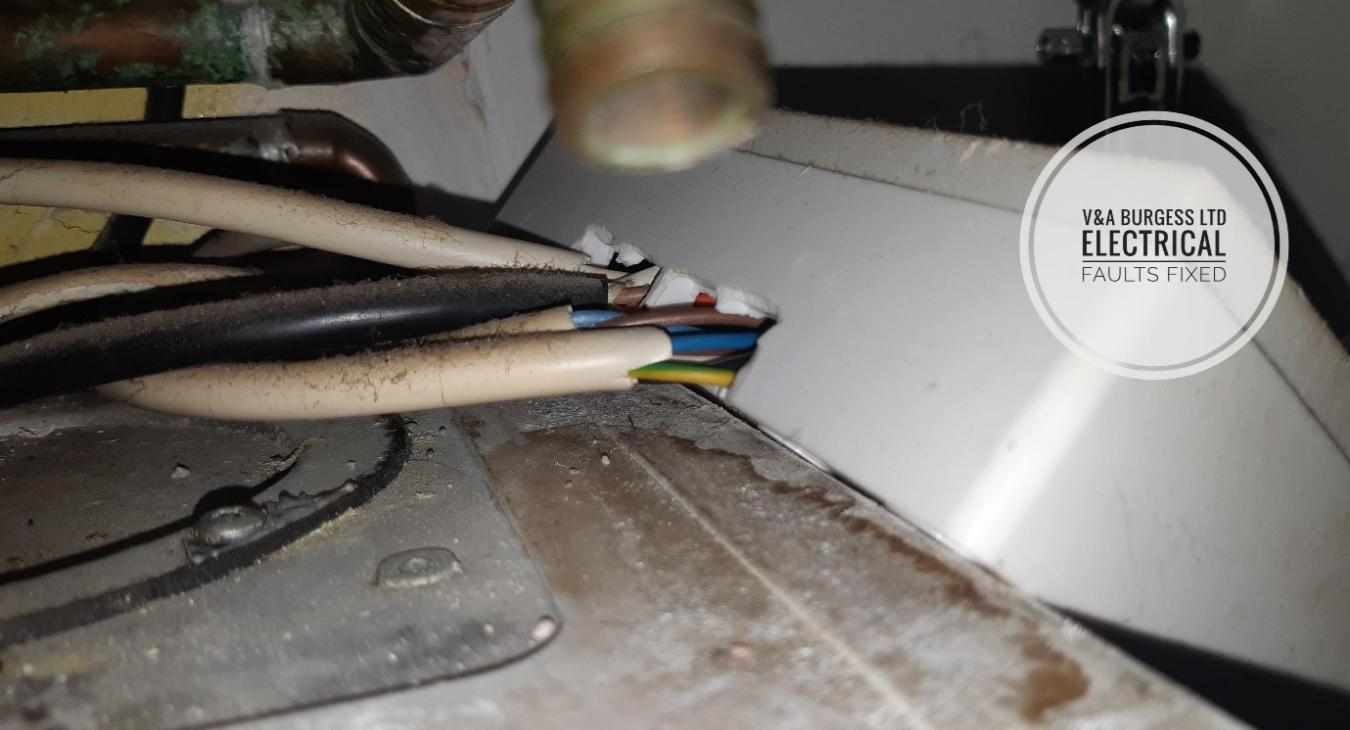
Table of Contents
Your home is important. It is the place where you spend most of your time and it needs to be safe and comfortable for you and your family. We can take our home for granted. Systems like piping and cabling can be forgotten for many years whilst they provide faithful service aiding your comfort and enjoyment of your home. We often do not question the safety of our electrical system as long as it appears to do its job then it must be safe right?
When wiring is carried out poorly then it puts everyone in the home at risk. Electrical repair and electrical installation work is skilled work which should only be carried out by a professional who can also TEST the work correctly once it has been done.
Back to top1) What Kinds of Things Constitute Bad Wiring?
There can be a several situations that would be considered ‘Bad Wiring’ such as:
- Loose Wires or Cables
- Plug Sockets that are unsecured
- Light Switches that are loose
- Undersized Cables
- Damaged Cables
- Very Old or Worn Cables
This list is by no means extensive and there are many different circumstances that could fall into the ‘bad wiring’ category. We shall take a look at the list above in some detail and with reference to the UK wiring regulations, explain WHY these issues are not only non-compliant but where danger is introduced.
Back to top2) Loose Wires
When wires are not secured properly, not only do they not comply with the regulations BUT they introduce danger. BS7671 wiring regulations state that cables must be adequately supported to avoid damage by mechanical stresses in regulation 522.8.
Section 134.1 relates to erection of electrical installations. In particular 134.1.1 states that good workmanship shall be used in order to erect the wiring installation whilst taking into account manufacturers instructions.
Loose wires do NOT comply with these regulations and MANY others. IF you spy loose cables in your wiring installation and you are at all concerned then contact your local electrician to have the matter rectified. Unfortunately, poor workmanship often does not stop at loose wires and it is common to find other more serious defects along with the issue of loose wiring.
Back to top3) Plug Sockets that are unsecured
Plug sockets that are unsecured can be an electrical shock risk, a fire risk and can easily become further damaged by accidental impacts. Connections can become loosened in the rear of the plug socket which can lead to a burnt plug socket through high resistance and heat build up.
Plug sockets must be correctly secured under regulation 134.1 relating to workmanship. Without correctly securing the plug socket we compromise any enclosing of live connections and essentially leave some level of access to live parts. This can contravene regulation 416.2.1 which outlines the minimum level of protection for enclosing live parts.
Unsecured plug sockets can certainly be considered BAD WIRING! An electrician may be needed to rectify an unsecured plug socket in some cases as there can be many reasons for a plug socket becoming loose.
Back to top4) Light Switches that are loose
Just as with plug sockets, light switches can also become loose and will also contravene regulation 134.1 along with 416.2.1 relating to the minimum degree of protection from live parts.
A common misconception is that lighting circuits are ‘less dangerous’ to people because they use less power or that sockets are more powerful and will likely give you a worse shock. This is largely untrue. The voltage in your home will generally remain the same no matter what circuit is in use (except for specially selected low voltage 12v lighting). It is the voltage that will ensure you receive a shock, burns or other injuries generally.
A loose light switch is equally as dangerous as a loose plug socket, loose cooker connection or any other circuit!
Back to top5) Undersized Cables
When cables are selected during the design stage of an electrical installation, certain aspects of design are considered such as ambient temperatures, design current, installation method, grouping factors introduced when cables run alongside others and more. There are tables in the wiring regulations (BS7617) to aid with the correct selection of cables for electricians and these should be consulted before installation takes place.
Once all these different considerations have been made, the cable is selected and installed. All should be fine and it normally is.
If the cable is undersized for the electrical demands placed upon it then it is highly probable that the cables will overheat dangerously and a fire will start. Electrical fires can be deadly and if poor system design and cable selection occurs then the electrical system is at risk!
Back to top6) Damaged Cables
Damage to cables can occur during installation, use, alteration or maintenance of wiring systems and it is important to have regular electrical inspections carried out to aid in the discovery of hidden cable damage. Some electrical panels will let you know when there is cable damage by way of a trip switch operating but, in some cases and under certain electrical fault conditions, switches may not trip!
Damaged cables not only present a fire risk to the property in which they are installed but are also most definitely, BAD WIRING.
Back to top7) Very Old or Worn Cables
Certain types of electrical cables have now gone past their usable and serviceable life in electrical installations. Generally these cable types would be:
- Aluminium cables
- VIR Rubber Cables
- Lead Sheathed Cables
8) Aluminium Cables
Aluminium wiring was used for a very short period in the United Kingdom due to worldwide copper shortages at the time. This was between 1972 and 1976 and as such would make the wiring system around 50 years old at the time of writing. The issues with Aluminium wiring is that it is exceptionally difficult to terminate into electrical accessories to any safe degree of tightness or torque. This leads to loose connections, overheating and fires. Aluminium is susceptible to crushing as it is tightened into connections whereas copper is far more resistive to crushing forces.
Back to top9) VIR Rubber Cables
The usage of rubber cables generally declined during the 1950s and was not used after this decade in electrical installations in the UK. If your home wiring system has rubber cables still in use then there is every chance that they are now dangerously brittle, are at risk of shorting out and causing serious electrical issues and have certainly served their useful purpose! Rubber cabling should generally be considered for replacement now and any wiring systems containing rubber sheathed cables should not be added on to or extended in any way without ensuring that the electrical system is up to modern safety standards.
Back to top10) Lead Sheathed Cables
These cables contained live conductors and had a lead outer sheath. They were often used in domestic plug socket circuits. They were not used beyond the 1950s in domestic electrical installations and if found should be inspected by an electrician to ascertain their safety. They have served their useful life and should be considered for replacement.
Back to top11) What about Safety Checks and Compliance
Under the wiring regulations we are required to carry out a sequence of testing to ensure that the safety of the installation is guaranteed. A qualified electrician should understand these tests, the results of these tests and if the installation complies with the safety regulations BS7671.
When wiring is carried out by someone other than a competent electrician it puts everyone that uses the electrical installation at risk as there is no guarantee of safety!
Back to top12) The “Did you know?” Section
Did you know… most of the equipment in your home will continue to function perfectly normally without an earth connection? You would never know UNTIL there was a fault when somebody would have received a dangerous shock.
Did you know…. There can be broken circuits in your home and you would never know until there was an overload and cabling was damaged or burned potentially causing a fire? Electricians can test to make sure circuits are complete, not damaged and have good test readings.
Did you know… Lots of homes have NO electric shock protection for the residents living there? Electric shock protection in the form of RCD devices has been around for many years, these are vital life saving devices and are now installed as standard. Some RCD devices are unsuitable for modern electrical appliances and equipment and an Electrician can check this for you.
Did you know... Electrical systems can survive several decades of use and will operate seemingly normally up until the point of their near total failure? Once electrical problems start to appear, it is sometimes because the system requires many repairs or rewiring.
We come across lots of bad wiring during our working week. We specialise in fault finding and repair and always try to leave an electrical installation safer than when we arrived. If you need a 24 hour Electrician, an emergency electrician or an electrician in Widnes, Liverpool or any of the L or WA postcodes then call us.











